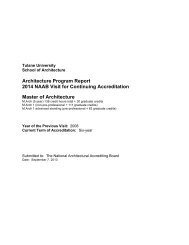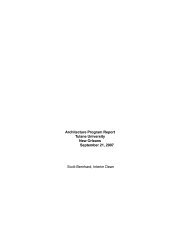NAAB Conditions for Accreditation, 2009 - Tulane School of ...
NAAB Conditions for Accreditation, 2009 - Tulane School of ...
NAAB Conditions for Accreditation, 2009 - Tulane School of ...
You also want an ePaper? Increase the reach of your titles
YUMPU automatically turns print PDFs into web optimized ePapers that Google loves.
<strong>2009</strong> <strong>Conditions</strong> <strong>for</strong> <strong>Accreditation</strong><br />
National Architectural Accrediting Board, Inc.<br />
PART ONE (I): SECTION 1 – IDENTITY & SELF-ASSESSMENT<br />
I.1.1 History and Mission: The program must describe its history, mission and culture and<br />
how that history, mission, and culture is expressed in a contemporary context. Programs<br />
that exist within a larger educational institution must also describe the history and mission<br />
<strong>of</strong> the institution and how that history, mission, and culture is expressed in a contemporary<br />
context.<br />
The accredited degree program must describe and then provide evidence <strong>of</strong> the<br />
relationship between the program, the administrative unit that supports it (e.g., school or<br />
college) and the institution. This includes an explanation <strong>of</strong> the program’s benefits to the<br />
institutional setting, how the institution benefits from the program, any unique synergies,<br />
events, or activities occurring as a result, etc.<br />
Finally, the program must describe and then demonstrate how the course <strong>of</strong> study and<br />
learning experiences encourage the holistic, practical and liberal arts-based education <strong>of</strong><br />
architects.<br />
The APR must include the following:<br />
A brief history <strong>of</strong> the institution, its mission, founding principles, and a description<br />
<strong>of</strong> how that is expressed in the context <strong>of</strong> 21 st century higher education<br />
A brief history <strong>of</strong> the program, its mission, founding principles, and a description <strong>of</strong><br />
how that is expressed in the context <strong>of</strong> the 21 st century architecture education.<br />
A description <strong>of</strong> the activities and initiatives that demonstrate the program’s benefit<br />
to the institution through discovery, teaching, engagement, and service.<br />
Conversely, the APR should also include a description <strong>of</strong> the benefits derived to<br />
the program from the institutional setting.<br />
A description <strong>of</strong> the program and how its course <strong>of</strong> study encourages the holistic<br />
development <strong>of</strong> young pr<strong>of</strong>essionals through both liberal arts and practicum-based<br />
learning.<br />
I.1.2 Learning Culture and Social Equity:<br />
Learning Culture: The program must demonstrate that it provides a positive and<br />
respectful learning environment that encourages the fundamental values <strong>of</strong><br />
optimism, respect, sharing, engagement, and innovation between and among the<br />
members <strong>of</strong> its faculty, student body, administration, and staff in all learning<br />
environments both traditional and non-traditional.<br />
Further, the program must demonstrate that it encourages students and faculty to<br />
appreciate these values as guiding principles <strong>of</strong> pr<strong>of</strong>essional conduct throughout<br />
their careers, and it addresses health-related issues, such as time management.<br />
Finally, the program must document, through narrative and artifacts, its ef<strong>for</strong>ts to<br />
ensure that all members <strong>of</strong> the learning community: faculty, staff, and students are<br />
aware <strong>of</strong> these objectives and are advised as to the expectations <strong>for</strong> ensuring they<br />
are met in all elements <strong>of</strong> the learning culture.<br />
<br />
Social Equity: The accredited degree program must provide faculty, students, and<br />
staff—irrespective <strong>of</strong> race, ethnicity, creed, national origin, gender, age, physical<br />
9














